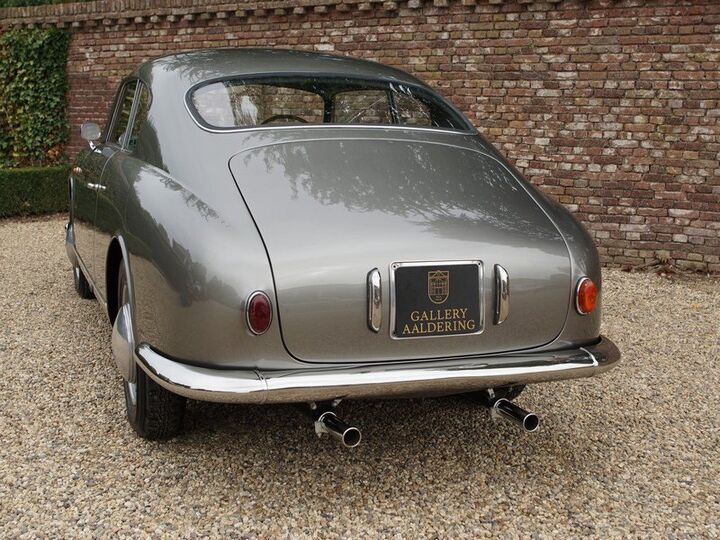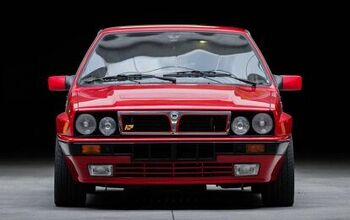Rare Rides: A Luxurious Lancia Aurelia From 1953

Rare Rides recently featured this car’s successor — the lovely Zagato-built Flaminia coupe from 1965. Today we’ll jump a decade prior and take a look at Lancia’s flagship offering from the Fifties.
Introduced for 1950, Lancia’s Aurelia was an attempt to branch into a new segment for the brand. Though Lancia offered large family cars in the past, and even an executive-class car (Artena), it had never produced a modern luxury car. The V4-powered Artena was discontinued after 1942, and Lancia hadn’t offered a V8 sedan since the Thirties. Aurelia was a very important car for the brand from Turin. In addition to its status as a new class entrant for Lancia, it was also the first car named after a Roman road: Via Aurelia. The naming idea stuck, as the roads-as-models theme continued at Lancia through the Seventies.
The luxurious Aurelia was offered in two-door coupe, roadster, and cabriolet styles, as well as a four-door sedan. Like the Flaminia which came later, a finished chassis was also made available for those enterprising Italian coachbuilders. Coupe versions were designed by Ghia and built at Pininfarina, which also constructed the cabriolet.
Another notable first happened in Aurelia: the world’s first production V6 engine, which powered all Aurelias. It was a Lancia 60-degree design and was available in displacements between 1.8 and 2.5 liters. Displacement grew as the years wore on. While most came fitted with a single carburetor, some Aurelias of more sporting pretensions used twin carbs in combination with the 2.0-liter engine. All Aurelias utilized a four-speed manual transmission. Sparing no expense on its development, Lancia created a unique transaxle for Aurelia and used inboard-mounted drum brakes. Holding the advanced design to the road was another first: Radial tires as standard equipment.
The Aurelia was made in six distinct series, mostly marked by engine advancements. Power climbed from 56 horses in series one to 80 in series two, and on to 112 in the sixth installment. Other changes along the way included the addition of luxury equipment, along with NVH refinements.
The Aurelia was due for replacement by 1958, as the more modern Flaminia entered the scene. All told, Lancia built some 18,201 Aurelias. Today’s Rare Ride is a series three example, originally sold in its right-hand drive format to a customer in New York. Carrying the largest 2.5-liter V6, it also features the uncommon Nardi floor shifter. Already restored, the Aurelia is one of 720 manufactured that year. Located in the Netherlands, it asks $179,000.
[Images: seller]

Interested in lots of cars and their various historical contexts. Started writing articles for TTAC in late 2016, when my first posts were QOTDs. From there I started a few new series like Rare Rides, Buy/Drive/Burn, Abandoned History, and most recently Rare Rides Icons. Operating from a home base in Cincinnati, Ohio, a relative auto journalist dead zone. Many of my articles are prompted by something I'll see on social media that sparks my interest and causes me to research. Finding articles and information from the early days of the internet and beyond that covers the little details lost to time: trim packages, color and wheel choices, interior fabrics. Beyond those, I'm fascinated by automotive industry experiments, both failures and successes. Lately I've taken an interest in AI, and generating "what if" type images for car models long dead. Reincarnating a modern Toyota Paseo, Lincoln Mark IX, or Isuzu Trooper through a text prompt is fun. Fun to post them on Twitter too, and watch people overreact. To that end, the social media I use most is Twitter, @CoreyLewis86. I also contribute pieces for Forbes Wheels and Forbes Home.
More by Corey Lewis
Latest Car Reviews
Read moreLatest Product Reviews
Read moreRecent Comments
- Turbo Is Black Magic My wife had one of these back in 06, did a ton of work to it… supercharger, full exhaust, full suspension.. it was a blast to drive even though it was still hilariously slow. Great for drive in nights, open the hatch fold the seats flat and just relax.Also this thing is a great example of how far we have come in crash safety even since just 2005… go look at these old crash tests now and I cringe at what a modern electric tank would do to this thing.
- MaintenanceCosts Whenever the topic of the xB comes up…Me: "The style is fun. The combination of the box shape and the aggressive detailing is very JDM."Wife: "Those are ghetto."Me: "They're smaller than a Corolla outside and have the space of a RAV4 inside."Wife: "Those are ghetto."Me: "They're kind of fun to drive with a stick."Wife: "Those are ghetto."It's one of a few cars (including its fellow box, the Ford Flex) on which we will just never see eye to eye.
- Oberkanone The alternative is a more expensive SUV. Yes, it will be missed.
- Ajla I did like this one.
- Zerofoo No, I won't miss this Chevrolet Malibu. It's a completely forgettable car. Who in their right mind would choose this over a V8 powered charger at the rental counter? Even the V6 charger is a far better drive.







































Comments
Join the conversation
Among the many foibles the lads at Lancia persisted with was RHD. Yes, despite the fact that they were an Italian company in a land where people drove on the right same as here in North America, Lancias had the steering wheel on the British/Japanese side. From 1955, LHD became an option on these GTs, and a special bunch of LHD vehicles went down with the SS Andrea Doria sinking off New York in 1956, where 46 people died. They're all rusty heaps now in their watery grave. A Chrysler with Italian bodywork also perished. I believe it was 1957 or later that LHD became standard for European though not British markets. The basic Aurelia sedan (berlina) which sold in greater quantities than these GTs was not quite the same aesthetic delight, ahem. They all had Lancia's sliding pillar front suspension, which is quite sophisticated in execution and operation. The first GT iterations from 1951 or so also had IRS, with a neat geometry that presaged Mercedes' 1983 multi-link rear, in that the rubber bushings took up the arm movements that were impossible if you assumed complete rigidity as they swung through their arcs. They had to do something at the rear, because they weren't going to have the huge transmission/differential transaxle and inboard braking system bouncing up and down on the cart springs virtually everyone else used at the time, and still a popular feature of Ford and Chevy pickups. The handling was apparently unpredictable unless you were a racing driver who could use the twitchiness to get the beast around curves. So for 1953 the IRS was replaced by a deDion tube that, it being Lancia and thus unconventional, was suspended on cart springs instead of coils. This cured the handling but showed that no Lancia was going to be like a normal car no matter what suspension solution they came up with. There's plenty of resources on the web about these old Lancias because they intrigue people, but that subsequent intrigue is born first from an appreciation of the fine looks. As I've said before, I've had drives in a '53 like this one, in Italian red, but way back in 1971 when I was on a study/grad work scholarship in the UK. It had a 2.3l version of the V6 and I have no idea which rear suspension it had as Lancia didn't really have model years like we're used to here. They used up parts until it was time for the change. Looking at these beasts now as an oldster, I want one bad. Lovely to look at, huge wheels that actually look right and actually are not ginormous when seen in isolation but normal. It's the styling which gives that impression. Detroit cars of that bulbous early '50s era had inboard-set wheels giving an impression of a hulk perched over tiny wheels. Back in 1971, I regarded the GT as some old monstrosity hobby car as it was 18 years old already, and I had no idea of the intricacy hidden underneath then. Funnily enough, neither did the owner, my boss, or at least he never mentioned it. But it didn't have the floor shifter, just the regular column type. And because I was in England the fact that the steering wheel was on the British side wasn't unusual. Little did I know the crazy Lancia guys made 'em all that way.
I've seen a 1955 Aurelia sedan in the metal, and I was struck by how small it was. It wasn't just as short as a Honda Civic coupe, but the width of the car was barely as much as the height, about 5 feet. It's lovely, but the pictures can fool you into thinking it's a much bigger car than the smallish compact it actually was.